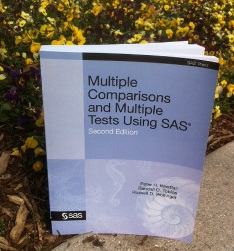This week's SAS tip comes from Peter Westfall, Randall Tobias, and Russell Wolfinger and their book Multiple Comparisons and Multiple Tests Using SAS, Second Edition. If you're interested in this topic, additional bonus content includes a free chapter from the book.
The following excerpt is from SAS Press authors Peter Westfall, Randall Tobias, and Russell Wolfinger and their book "Multiple Comparisons and Multiple Tests Using SAS, Second Edition" Copyright © 2011, SAS Institute Inc., Cary, North Carolina, USA. ALL RIGHTS RESERVED. (please note that results may vary depending on your version of SAS software)
Examples Using Combined Power Definitions
While individual power refers to a particular hypothesis, complete, minimal, and proportional power involve several hypotheses simultaneously. As such, their calculations are complicated by the fact that they depend on the specific alternative settings for all non-null hypotheses, not just the alternative setting for a particular test of interest. Calculations are further complicated for complete and proportional power because they require the multivariate non-central distribution of the test statistics.
The result of this complication is that calculating the power analytically is often infeasible for the combined power definitions. However, as in the case of computing the tests themselves, simulation can yield useful, if slightly imprecise, results. For example, the %SimPower macro, defined on the authors’ Web pages, computes the complete, minimal, and proportional power for specified input parameters. It is invoked as follows:
where
- METHOD is the multiple comparisons method, whether all pairwise comparisons (METHOD = TUKEY, the default), two-sided comparisons with control (METHOD = DUNNETT), one-sided comparisons with a control (either METHOD = DUNNETTL or METHOD = DUNNETTU) or REGWQ (defined in Chapter 14). In addition to TUKEY, DUNNETT, DUNNETTL, DUNNETTU, and REGWQ for the METHOD= parameter, you can specify SIMULATE, so long as you also specify DIFF= to say what types of diffs, and you can also include STEPDOWN(TYPE= ), where the TYPE= variable is LOGICAL, LOGICAL(0), LOGICAL(1),…, or FREE.
- NREP is the number of simulations, with 1000 as the default.
- N is the within-group sample size (if equal) or list of within-group sample sizes (if unequal). You must specify N; there is no default.
- S is the underlying population standard deviation; there is no default.
- FWE is the desired FWE, with 0.05 as the default.
- TRUEMEANS lists the true group means. You must specify the TRUEMEANS list; there is no default. An example: TRUEMEANS = (10,5,5,0,0).
- SEED is the seed value, with 0 (computer clock time) as the default.





